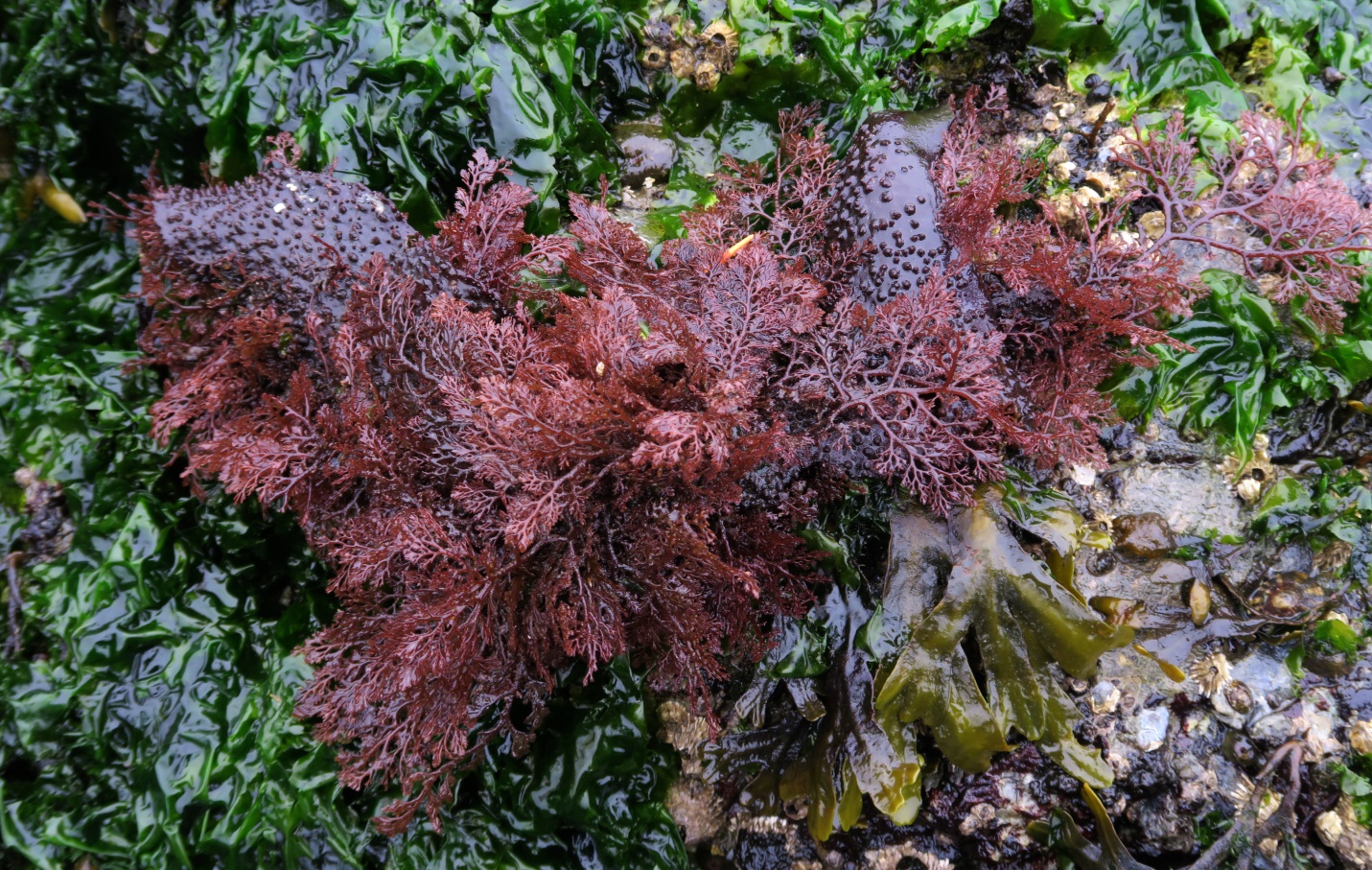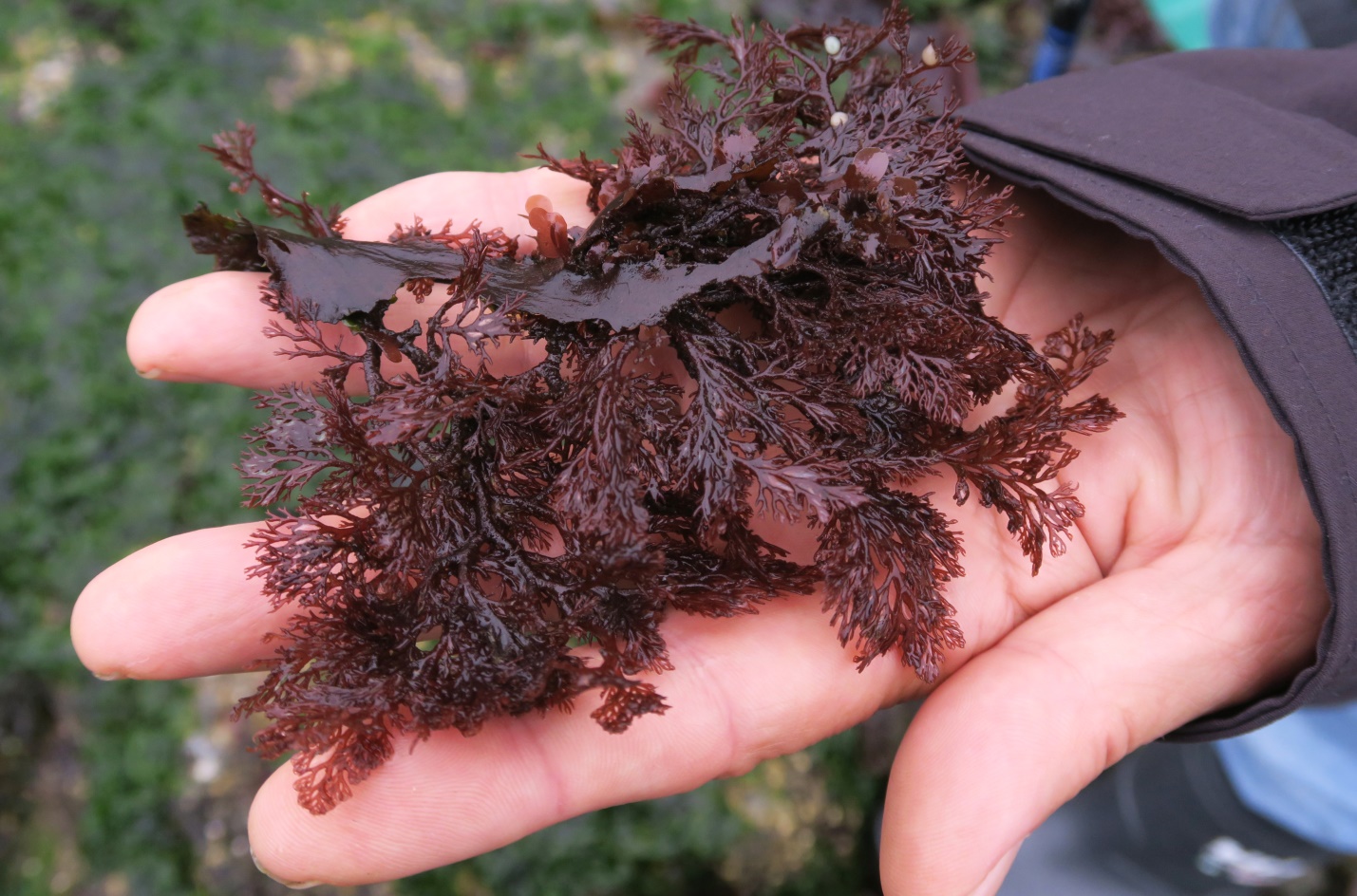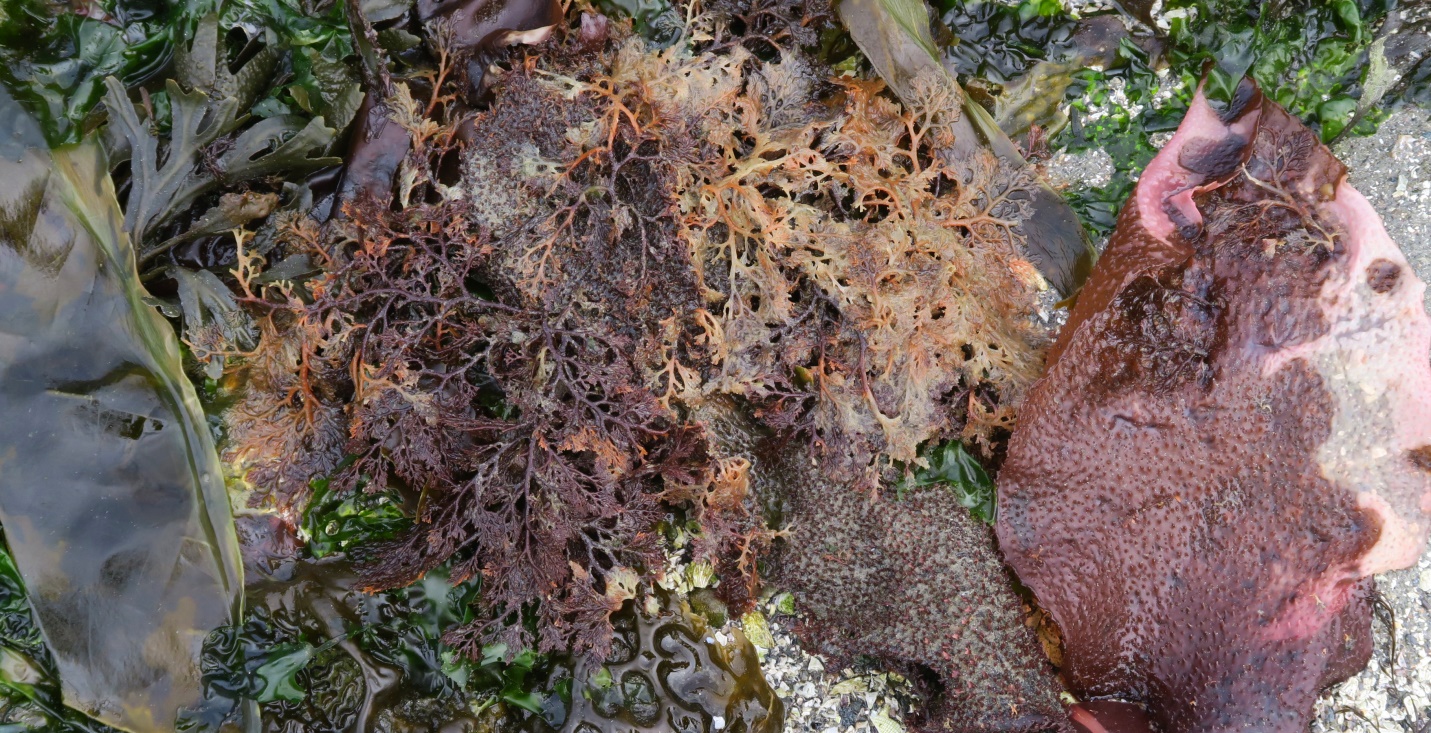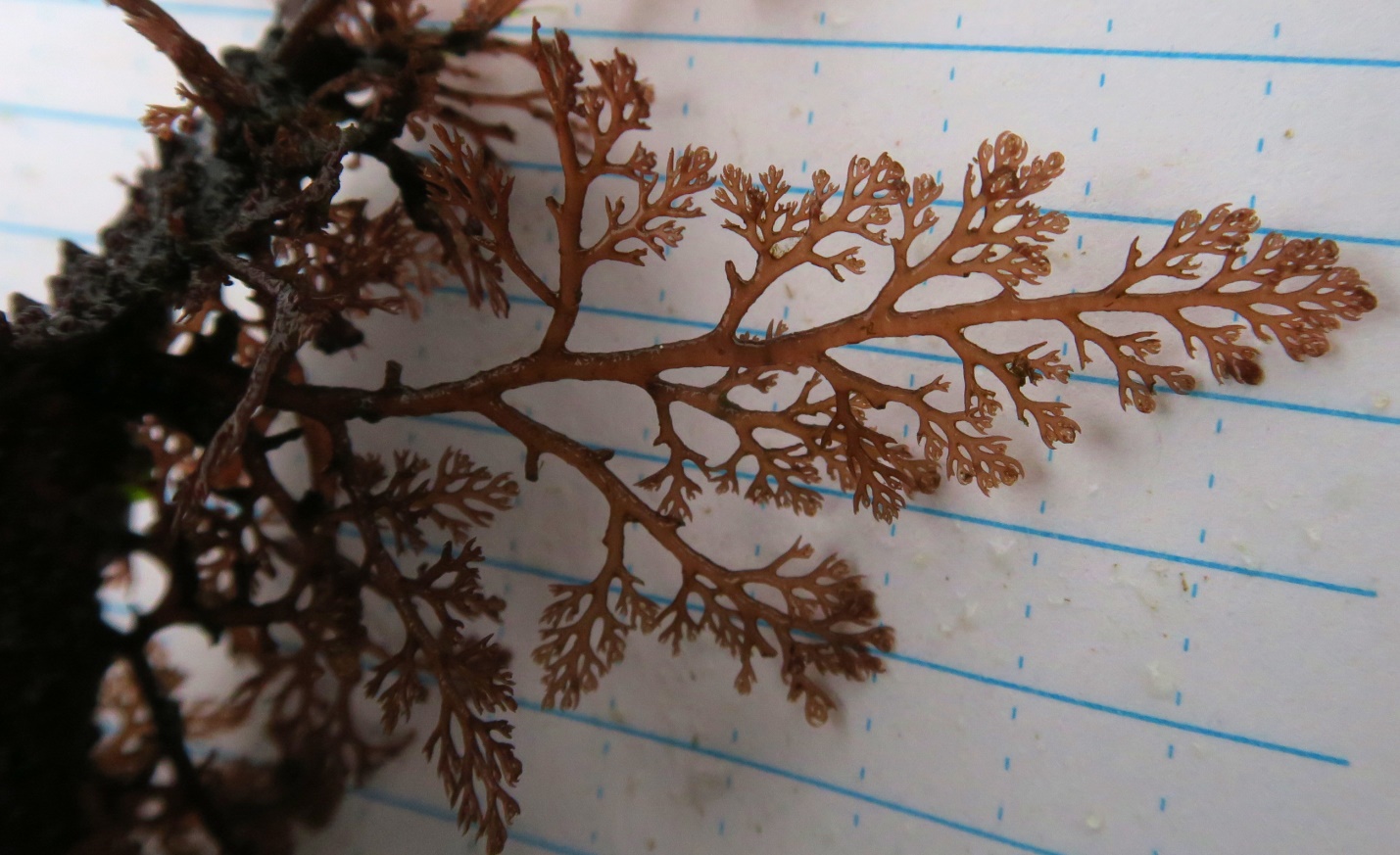
Microcladia coulteri
Delicate Sea Lace
20 August 2021; interactions commenced 08:22 PDT
Gonzales Bay, Juan de Fuca Strait, B.C., Canada.
Tide: 0.7 foot tide 08:39 PDT (measured at Oak Bay Tidal Station)
Conditions: Overcast, light fog, wind variable 0 – 5 km/hr, sea smooth, 14 ˚C, relative humidity 95%.
Phase of Moon: Waxing Gibbous (approx 45 hours prior to the Full Moon at time of interaction); Previous Phase, First Quarter, 15 August 2021 at 8:19am PDT: Next Phase, Full Moon, 22 August 2021 at 5:01am PDT.)

Figure 1: One of many similar finds this day, Microcladia coulteri is seen here almost obliterating its host with its prolific, delicate-looking, lacy growth. Gonzales Bay, Juan de Fuca Strait, B.C., Canada. August 20, 2021. Photo ID 27280 ©Seaweedwhisperings.com
Person 1:
Attaches mainly near edges of host.
Likes life on the edge.
Carefree… we’ve nicknamed this seaweed “hitchhiker seaweed” which has the characteristic of being carefree.
Social, but self-absorbed.
Not particularly picky about a host, just wants something / someone to give it a joyful ride.
Can grow so big…, not the individual plant, but when many hitchhikers get together, then they form a big presence, bigger than the host.
Then the ride gets out of control.
Purple-y reddish brown in color.
Branches alternately, indefinitely – no end in sight, like it keeps going.
No plans, just grow / just go.
Firmly attached to host – won’t let go. When tugged on by the central stem it doesn’t break from host, rather it holds on and the host itself tears away with Microcladia coulteri still clinging to it. It didn’t snap itself; it took a piece of the host with it.
Slightly rough to the touch.
Tickles my face like a feather; may be a bit of a tease.
Stems flattened somewhat.
Independent, not so much, although we chose different specimens to interact with and sat about 6 meters apart. Wanting space? Or, do others want space from it?
Maintains composure when out of its element but is not happy to not be playing.

Figure 2: This adrift & beached piece of Chondracanthus exasperatus (burgundy colored flat blade that is dotted with bumps) is abundantly covered with Microcladia coulteri thalli (lacy lighter red). Gonzales Bay, Juan de Fuca Strait, B.C., Canada. August 20, 2021. Photo ID 27281 ©Seaweedwhisperings.com
Person 2:
You are calling out today – simply because of the multitude of individuals observed - you are everywhere, almost. On almost any scrap of red seaweed I find, there you are.
Obvious. Noticeable.
On some pieces, like this Turkish Towel remnant, you almost obliterate your host, you are so plentiful.
On other pieces, I see individual stems of you, often growing on or very near the margins (edges) of the big broad blades.
Is this so you can have light no matter which way the big blade is oriented? So it cannot shade you out?
Very clever!
It seems to indicate that if you do not choose a host or your placement well, you will suffer and be powerless to move or help yourself by your own actions.
Your look is that of a delicate and pretty lace. But what you do, your way of thriving, is to grab onto someone stronger and not just cling, but to actually penetrate and anchor within them. Then, if you do well and are given enough time, you take over. You dominate the surface with your growth, with your look, with your presence. That energy is not so pretty or delicate!
It seems not regulated, having no interest in or regard for boundaries and limits AND, indeed, I think when you overtake your host so much, your presence creates a drag and makes the host more vulnerable to being torn away from its holdfast. And that serves neither of you!!
Then you both wash ashore and, Microcladia coulteri, this is the beginning of your death. No longer situated in suitable habitat, you cannot conduct photosynthesis, the rays of light are too intense, and your pretty rosy stems fade to orange and then ultimately bleach out to white.
Touching your fronds with my fingers I find that you feel more wiry than I may have expected. Wiry, as in thin, and possessing some strength in that thinness.
My specimen is out of water but I also note that it has a “dry feel”. Maybe you’re good at brushing or sweeping like a fine net or fan?
What does that help you capture? That word, “capture” is what leapt to mind; I do think you capture rather than attract or entice.
Are any invitations you issue turned down?
Hitchhiker seaweed you seem to be rich with contradictions.
Pretty to look at but overwhelming to those you get close to.
Tiny and delicate but wiry and strong.
Inconsiderate or oblivious to your host – and therefore you are disliked and also often an agent of peril.
You grow on other red seaweeds; do you think that hides you? Because once you really get growing you are anything but hidden!
You cannot exist on your own, but your invitations to others are not welcomed.
Contradictions are numerous. Maybe this is demonstrated physically with your alternating branch pattern.
Do you get stopped yourself, Delicate Sea Lace, by dealing with inner contradictions?
Today in this one location we observed Microcladia coulteri growing on the follow red seaweeds:
Condracanthus exapseratus
Palmaria mollis
Mazzaella splendens
Cyrptopleura ruprechtiana
Prionitis sternbergii

Figure 3: Microcladia coulteri – this grouping is growing on a piece of Cryptopleura ruprechtiana. The seaweed’s size and color shows nicely in hand. Gonzales Bay, Juan de Fuca Strait, B.C., Canada. August 20, 2021. Photo ID 27282 ©Seaweedwhisperings.com
Discussion:
Person 1 felt the “carefree” aspect of the ‘hitchhiker’ theme. Person 2, when considering this theme felt another aspect entirely. The feeling she felt in interacting with this seaweed’s energy is that of the person who is a hitchhiker because of poverty, they don’t own their own car or can’t maintain one, and so if they want to travel they must ‘beg a ride’ and in that sense they’re “needy”, or they’re simply choosing to rely on the resources of others rather than innate self-reliance.
The appearance of the seaweed is attractive, quite a lovely lacy and delicate pattern, but the energy has a totally different feel – it’s overpowering in its neediness, dramatic in its displays, and more or less consistently draining the energy of others, sometimes to the point of unintentionally endangering them.
Microcladia coulteri does not seem to try to choose good associates / hosts, it feels more like it really doesn’t give this much thought, just grabs the nearest support. By the numbers of specimens seen here today, it seems that Delicate Sea Lace is very skilled at this!

Figure 4: Aging and bleaching, the flattened mass of Microcladia coulteri in the center of this photo displays coloration ranging from rose-red, through orange, to straw yellow. Another red alga, the adjacent Chondracanthus exasperatus blade is also bleaching (pink to almost white). Gonzales Bay, Juan de Fuca Strait, B.C., Canada. August 20, 2021. Photo ID 27283 ©Seaweedwhisperings.com
Biology & Natural History Information:
Description:
Delicate Sea Lace is a flattened, rose-red, highly branched alga with inwardly curved (forcipate) branch tips that resemble tiny pincers or crab claws. It has multiple orders of alternating branches that arise from a straight axis; this growth pattern gives the seaweed a fairly symmetrical appearance. Usually growing to lengths of 10 to 20 cm, in good conditions Microcladia coulteri can reach twice that size.
Habitat:
This red alga grows on rocks and epiphytically on other seaweeds, sometimes so thickly as to obscure the host alga, of the mid and low intertidal to shallow subtidal regions of semi-exposed shorelines. Commonly noted hosts include Mazzaella spp., Chondrachanthus spp., Prionitis sternbergii, and Prionitis lanceolata (formerly Grateloupia americana).
Distribution:
The range of this species is from Haida Gwaii, B.C., Canada to Baja California, Mexico.
Remarks:
Although most epiphytic algae simply grow on top of their hosts, perched there so to speak, Microcladia coulteri actually produces small filaments that penetrate the tissue of their host. They ‘root’ themselves firmly in this manner.
Classification:
Phylum: Rhodophyta
Class: Florideophyceae
Order: Ceramiales
Family: Ceramiaceae
Genus: Microcladia
Species: Microcladia coulteri Harvey 1853

Figure 5: Microcladia coulteri, close in, larger than life-sized view of one thallus; for size perspective note that the actual size of the spacing between the blue notebook lines is 6mm. The tiny pincers that each branchlet terminates in are a distinguishing identification feature. Gonzales Bay, Juan de Fuca Strait, B.C., Canada. August 20, 2021. Photo ID 27284 ©Seaweedwhisperings.com
![]()